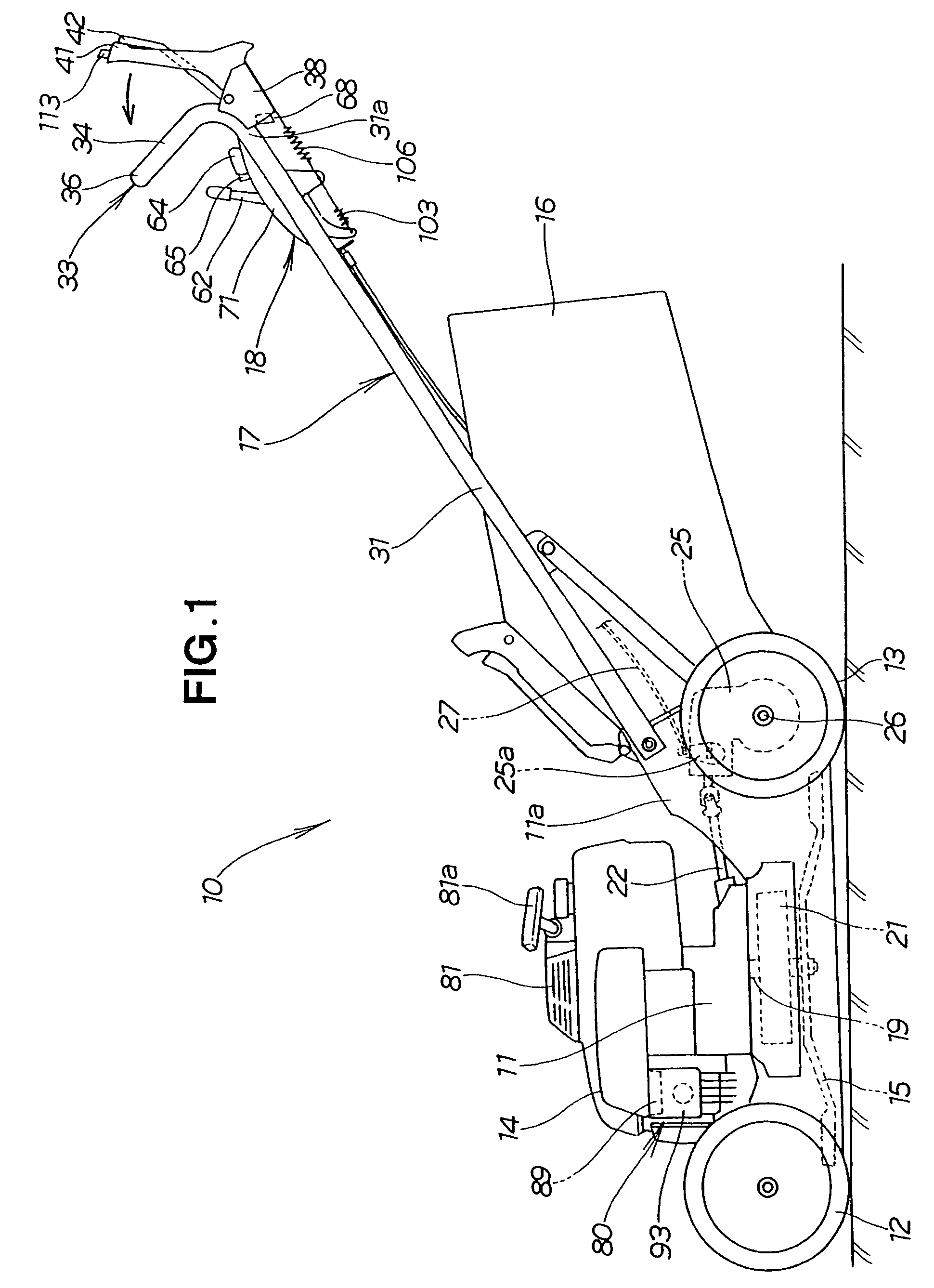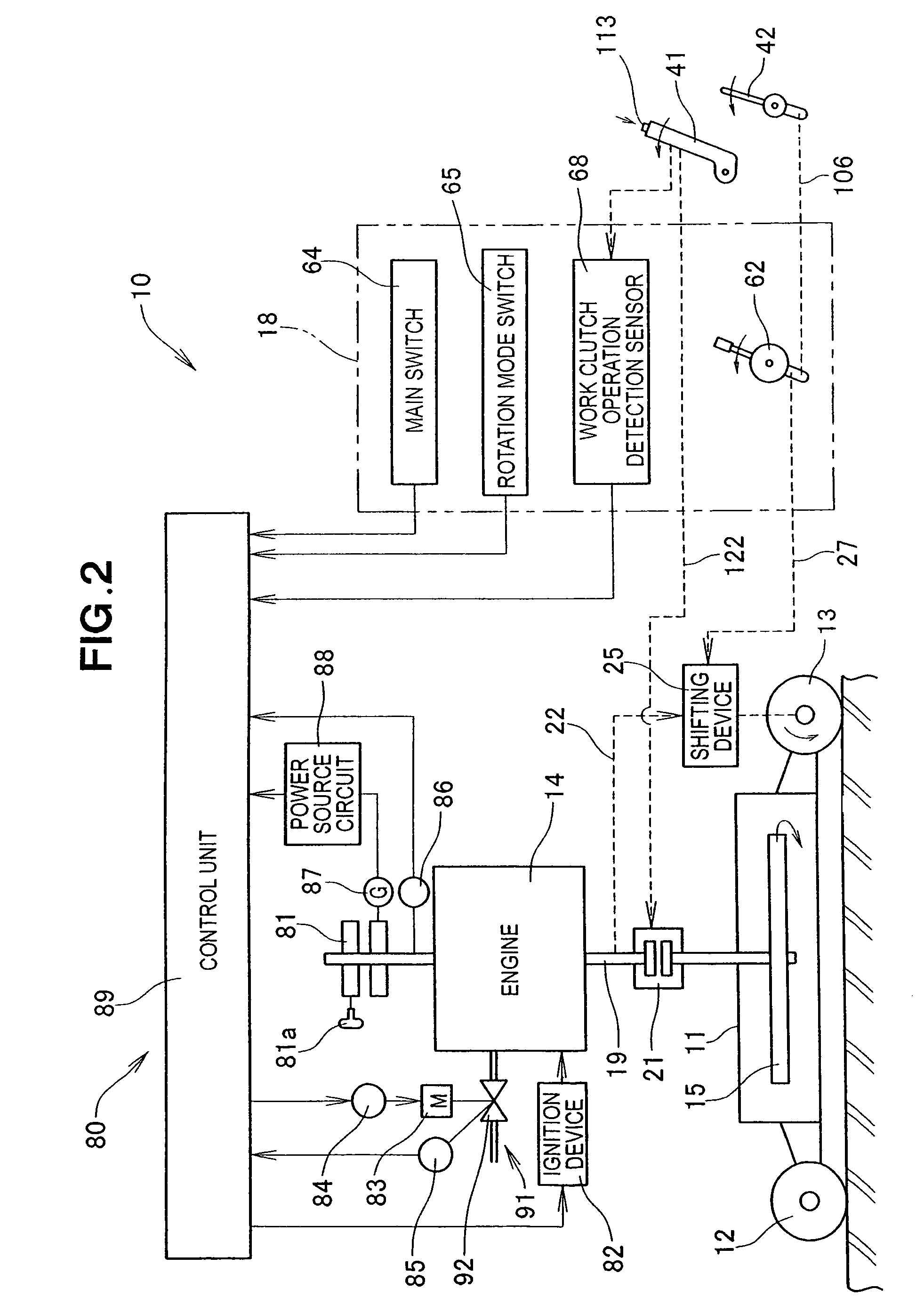Enigne-driven work machine
a work machine and engine technology, applied in the direction of electrical control, agriculture tools and machines, agriculture, etc., can solve the problems of engine speed remaining high, engine output is too low to handle load, and operator's difficulty in moving the throttle lever, so as to improve the ease of operation and the working efficiency of the engine-driven work machine, finely adjust the target engine speed, and easily adjust the engine speed
- Summary
- Abstract
- Description
- Claims
- Application Information
AI Technical Summary
Benefits of technology
Problems solved by technology
Method used
Image
Examples
first embodiment
[0091]A first embodiment will now be described, based on FIGS. 1 through 11C, and using a walk-behind lawnmower as an example of an engine-driven work machine according to the present invention.
[0092]FIG. 1 shows the structure of the walk-behind lawnmower 10 of the first embodiment as viewed from the left side. The walk-behind lawnmower 10 of the first embodiment is a type of engine-driven work machine that is steered by a walking operator using a handle 17, and is (is self-propelled) by the output of an engine 14. The walk-behind lawnmower 10 is composed of a housing 11 whose lower surface is open, left and right front wheels 12, left and right rear wheels 13, an engine 14, a cutter 15, a handle 17, an operating unit 18, a work brake / clutch unit 21, and a travel shifting device 25.
[0093]The housing 11 is provided with the left and right front wheels 12, the left and right rear wheels (drive wheels) 13, the engine 14, and other main components, and therefore also functions as the ma...
second embodiment
[0205]The engine 14 of the second embodiment is mounted on the upper portion of a casing 201, and is a power source having an output shaft 19 that extends downward from the lower end portion of the engine 14.
[0206]As described above, the casing 201 is provided with the engine 14, a power transmission mechanism 203, the first and second tilling plates 205, 206, the resistance rod 207, and other main components, and therefore also functions as the machine body (frame) of the walking-type tiller 200. The casing 201 will be referred to hereinafter as the “machine body 201”, or “frame 201” as appropriate.
[0207]A clutch 202 disengages and engages the output transmitted from the engine 14 to the first and second tilling plates 205, 206. The power transmission mechanism 203 is connected to the output shaft 19 of the engine 14 in the casing 201 via the clutch 202, and is composed of a transmission shaft 211 and a bevel gear mechanism 212 for transmitting the output of the engine 14 to the ti...
third embodiment
[0230]The control modes whereby the control unit 89 of the third embodiment controls the speed of the engine 14 are broadly classified into two rotation control modes. These rotation control modes are defined as described below.
[0231]The first rotation control mode is an “idle mode” for controlling the engine speed so as to obtain the engine speed of an idling state. The second rotation control mode is a “work mode” in which the work clutch lever 41 is operated to engage the clutch 21 (clutch on), whereby control is performed to obtain the engine speed of a state in which work is performed using the torque generated by the engine 14.
[0232]The concept of control whereby the control unit 89 controls the speed of the engine 14 according to the work mode will next be described based on FIG. 18.
[0233]FIG. 18 is a conceptual diagram of the control performed by the control unit of the third embodiment, wherein the horizontal axis indicates the throttle valve angle Thr (deg.), and the verti...
PUM
 Login to View More
Login to View More Abstract
Description
Claims
Application Information
 Login to View More
Login to View More - R&D
- Intellectual Property
- Life Sciences
- Materials
- Tech Scout
- Unparalleled Data Quality
- Higher Quality Content
- 60% Fewer Hallucinations
Browse by: Latest US Patents, China's latest patents, Technical Efficacy Thesaurus, Application Domain, Technology Topic, Popular Technical Reports.
© 2025 PatSnap. All rights reserved.Legal|Privacy policy|Modern Slavery Act Transparency Statement|Sitemap|About US| Contact US: help@patsnap.com



